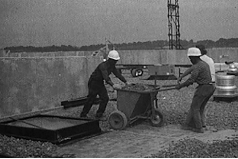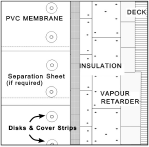Thermoplastics are synthetic (polymeric) sheets that can be softened by an increase in temperature and hardened when the temperature decreases. For this reason, thermoplastic sheets tend to be stiff in cold weather and soft and pliable in hot weather. If the temperature is high enough, the material will flow like a thick liquid and it is this property that allows the seams of the membrane sheets to be heat welded.
Thermoplastic membranes are generally resistant to acids, oils and bacteria. The membranes come in a variety of colours and thicknesses, typically ranging from 0.89 mm to 2.29 mm (35 to 90 mils), depending on type of membrane and manufacturer. Although non-reinforced membranes are available, the types of thermoplastic membranes that are commonly used in roofing are reinforced with polyester or fibreglass. This reinforcement makes the membrane stronger and more stable.
Because of their flexibility, thermoplastic membranes can be installed on a wide variety of roof shapes and sizes, including barrel, arched or domed roofs. They can also be used for waterproofing foundation walls, tunnels, basements and other underground structures.
Thermoplastic single ply membranes include:
- Polyvinyl chloride (PVC)
- PVC alloys; copolymer (CPA), ethylene interpolymer (EIP), or nitrile alloy (NBP)
- Thermoplastic polyolefin (TPO)
- Ketone ethylene ester (KEE)
The most widely available thermoplastic roof membranes in Canada are TPO and PVC.
Thermoplastic membranes may be installed in one of the following methods:
- Fully adhered
- Loose-laid ballasted
- Mechanically fastened
- Heat induction welding
Fully Adhered Systems
 In a fully adhered system, the membrane is bonded to the substrate, typically with a liquid applied contact adhesive. However, some membranes come with a laminated fleece backing that allows for other types of adhesives to be used, such as hot asphalt or low-rise polyurethane foam. Depending on the texture and porosity of the substrate surface, the adhesive will be typically applied at the rate of 0.5 to 0.8 l/m² (1.2 to 2 gal/square). An absorbent surface will require more adhesive than a smooth one. Only the type of adhesive and applications recommended by the manufacturer should be used.
In a fully adhered system, the membrane is bonded to the substrate, typically with a liquid applied contact adhesive. However, some membranes come with a laminated fleece backing that allows for other types of adhesives to be used, such as hot asphalt or low-rise polyurethane foam. Depending on the texture and porosity of the substrate surface, the adhesive will be typically applied at the rate of 0.5 to 0.8 l/m² (1.2 to 2 gal/square). An absorbent surface will require more adhesive than a smooth one. Only the type of adhesive and applications recommended by the manufacturer should be used.
Thermoplastic single-ply sheets with laminated pressure-sensitive adhesive also are available as well as velcro systems. These products are self-adhering and do not require the use of additional adhesives.
Loose-Laid Ballasted Systems
In loose-laid ballasted systems, the membrane is rolled out loose over the substrate with the membrane being held in place by a covering of ballast which typically consists of 19 mm to 38 mm (¾ to 1 ½ in) nominal sized round river washed stone. Crushed gravel (25 mm (1 in) clear or greater) can also be used as ballast, but a protection mat must be put down over the membrane prior to placing the gravel ballast to prevent damage to the membrane. Ballast stone should meet the membrane manufacturers requirements for the desired wind uplift resistance with regard to size and coverage rates. It is typically required that stone ballast meet the requirements of ASTM D448 size 4, 357 or 3, with larger stone size required for heavier coverage rates. Concrete pavers can also be used in place of ballast.
Although the ballast holds the membrane in place, the membrane must be mechanically attached at the perimeters of the roof and around roof penetrations with appropriate, approved fastening systems.
 On most loose-laid ballasted roofs, the stone ballast is applied at a rate of approximately 60 kg/m2 (1200 lb/square). In regions of high wind, additional ballast or other additional securement methods may be required for all or portions of the roof area. Because the materials including the ballast are loosely laid, roof slope is an important factor. Loose-laid systems are typically limited to slope rates of less than 1:25.
On most loose-laid ballasted roofs, the stone ballast is applied at a rate of approximately 60 kg/m2 (1200 lb/square). In regions of high wind, additional ballast or other additional securement methods may be required for all or portions of the roof area. Because the materials including the ballast are loosely laid, roof slope is an important factor. Loose-laid systems are typically limited to slope rates of less than 1:25.
Mechanically Fastened Systems
In a mechanically fastened system, a variety of methods are used to secure the membrane including:
 Metal disks placed in the seam and attached through the membrane into the roof deck.
Metal disks placed in the seam and attached through the membrane into the roof deck.- Metal or plastic bars placed in the seam and attached through the membrane into the deck.
- Metal and plastic disks and/or bars placed over the membrane and covered with membrane stripping.
The fasteners used to secure the disks or bars must be of sufficient strength and sufficient length to penetrate into thick wood decks by at least 25 mm (1 in) and trough wood panel or steel decks by 12.7 mm (1/2 in).
Heat induction welding
Heat induction welding is an alternative method to mechanical attachment. Induction welding uses an electromagnetic welding tool to bond the membrane to specially coated plates that have been used to fasten the insulation and cover board to the deck. The plate positioning and density is specifically designed to properly secure both the insulation and the roof membrane to resist the design wind uplift pressures. The membrane is bonded to the fastening plates without membrane penetration or a fastener line at sheet seams.
